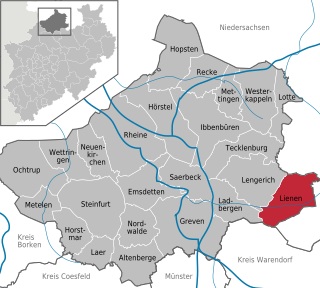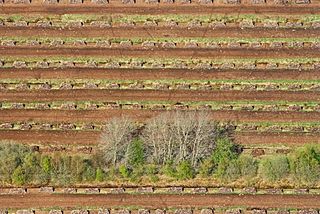
Westphalia is a region in northwestern Germany and one of the three historic parts of the state of North Rhine-Westphalia. It has an area of 20,208 km2 (7,802 sq mi) and 7.9 million inhabitants.

Nienburg is a district (Landkreis) in Lower Saxony, Germany. It is bounded by the districts of Diepholz, Verden, Heidekreis, Hanover and Schaumburg, and by the state of North Rhine-Westphalia.

Gelsenkirchen is the 11th largest city of Germany's most populous federal state of North Rhine-Westphalia and its 262,528 (2016) inhabitants make it the 25th largest city of Germany. On the Emscher River, it lies at the centre of the Ruhr, the largest urban area of Germany, of which it is the fifth largest city after Dortmund, Essen, Duisburg and Bochum. The Ruhr is located in the Rhine-Ruhr Metropolitan Region, one of Europe's largest urban areas. Gelsenkirchen is the fifth largest city of Westphalia after Dortmund, Bochum, Bielefeld and Münster, and it is one of the southernmost cities in the Low German dialect area. The city is home to the famous football club Schalke 04, which is named after Gelsenkirchen-Schalke. The club's stadium Veltins-Arena, however, is located in Gelsenkirchen-Erle.
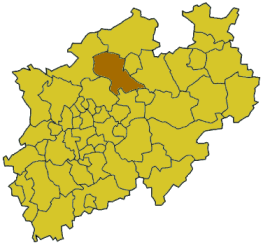
Coesfeld is a Kreis (district) in the northwestern part of North Rhine-Westphalia, Germany, west of the city of Münster. Neighboring districts are Steinfurt, district-free Münster, Warendorf, district-free Hamm, Unna, Recklinghausen, Borken.

Mesum is a village south of Rheine, located in the district Steinfurt, part of North Rhine-Westphalia. The current population in 2004 is about 8500. Mesum was first mentioned in 1373 in a document listing the church. That old church still exists as the oldest building of the village.
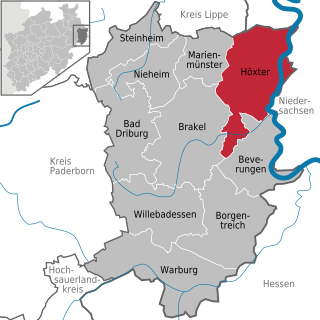
Höxter is a town in eastern North Rhine-Westphalia, Germany on the left bank of the river Weser, 52 km north of Kassel in the centre of the Weser Uplands. The main town's population is around 15,000, and with outlying centres, about 30,000. It is the seat of the Höxter district.

Halle, officially Halle (Westf.) or Halle Westfalen to distinguish it from the larger Halle (Saale), is a town in the German Bundesland of North Rhine-Westphalia, 15 km west of Bielefeld, and belongs to the district of Gütersloh in the region of Detmold.

Werne is a town in the Federal state of North Rhine-Westphalia in the Unna district in Germany. It is located on the southern edge of the Münsterland region near the Ruhrgebiet. The population of Werne is about 32,000.
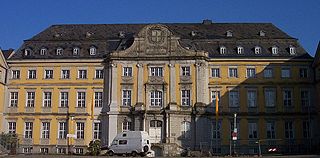
Werden Abbey was a Benedictine monastery in Essen-Werden (Germany), situated on the Ruhr.

Kaarst is a town in Germany. It lies in the district of Rhein-Kreis Neuss in North Rhine-Westphalia. It is 5 km west of Neuss and 12 km east of Mönchengladbach.

Wettringen is a village and a municipality in the district of Steinfurt, in North Rhine-Westphalia, Germany.

Ochtrup is a town in the district of Steinfurt, in North Rhine-Westphalia, Germany. It is situated approximately 20 km west of Rheine and 20 km east of Enschede.

Ostbevern is a municipality in the district of Warendorf, in North Rhine-Westphalia, Germany.
Liesborn Abbey was a Benedictine monastery in Liesborn, in what was originally the Dreingau, now a part of Wadersloh in the district of Warendorf in North Rhine-Westphalia, Germany.
Kinderhaus is a district of Münster, a city in North Rhine-Westphalia, Germany. It lies approximately 4 km to the north of the centre of Münster and belongs to the borough Münster-Nord, together with Coerde and Sprakel. It has 16,000 inhabitants and is mainly a residential area, though it has attracted some service enterprises, primarily in a large strip mall surrounding the Bürgerzentrum.
Kattenvenne is a village located in North Rhine-Westphalia, Germany.
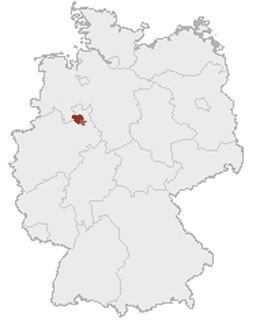
The Ravensberg Basin or Ravensberg Hills is a natural region in the governorate of Detmold (Ostwestfalen-Lippe) in the northeastern part of the German state of North Rhine-Westphalia; small elements also fall within the neighbouring state of Lower Saxony. It is part of the lower Weser Uplands and includes the hilly basin country between the Wiehen Hills in the north, Lippe Uplands in the east, Teutoburg Forest in the south and Osnabrück Hills in the west. The heart of the Ravensberg Basin is almost coincident with the cultural region of the Ravensberg Land.

Ravensberg Land is a cultural landscape in the district of Ostwestfalen-Lippe in the northeast of the German federal state of North Rhine-Westphalia. It lies between the Wiehen Hills to the north, the Teutoburg Forest to the south, the state border with Lower Saxony to the west and the large bend in the River Weser and the boundary of Lippe district to the east. It thus essentially encompasses the Westphalian part of the Ravensberg Hills. The most important towns are Bielefeld, Herford, Bad Oeynhausen and Bünde.

Witzhelden is a small town located in the district of Leichlingen near the cities of Düsseldorf, Solingen, and Cologne in the state of North Rhine-Westphalia in Germany.
Hunsche F.E.: Lienen am Teutoburger Wald; Lengericher Handelsdruckerei, 1965.


